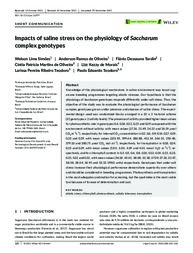Impacts of saline stress on the physiology of Saccharum complex genotypes.
Impacts of saline stress on the physiology of Saccharum complex genotypes.
Author(s): SIMOES, W. L.; OLIVEIRA, A. R. de; TARDIN, F. D.; OLIVEIRA, C. P. M. de; MORAIS, L. K. de; TEODORO, L. P. R.; TEODORO, P. E.
Summary: Knowledge of the physiological mechanisms in saline environment may boost sugarcane breeding programmes targeting abiotic stresses. Our hypothesis is that the physiology of Saccharum genotypes responds differently under salt stress. Thus, the objective of the study was to evaluate the physiological performance of Saccharum complex genotypes grown under presence and absence of saline stress. The experimental design used was randomized blocks arranged in a 32 × 2 factorial scheme (32 genotypes × 2 salinity levels). The presence of salinity provided higher mean values for photosynthetic rate in genotypes G4, G18, G22, G25 and G29 compared with the environment without salinity, with mean values (17.26, 21.49, 24.22 and 26.19 µmol CO2m?2s ?1), respectively, for internal CO2 concentration in G2, G6, G9, G14, G17, G19, G23 and G29, with mean values (323.45, 399.64, 386.88, 412.14, 366.31, 250.48, 379.10 and 380.75 µmol CO2 mol air?1), respectively, for transpiration in G18, G24, G25 and G29, with mean values (5.05, 3.30, 4.39 and 4.01 mmol H2O m?2s ?1), respectively, and for chlorophyll content in G3, G5, G6, G8, G10, G13, G20, G22, G23, G25, G31 and G32, with mean values (34.18, 43.01, 38.08, 32.38, 37.09, 37.18, 32.47, 38.38, 38.04, 36.95 and 33.32 SPAD units) respectively. Genotypes that under salt stress increase their physiological performance demonstrate superiority over others and should be considered in breeding programmes. Photosynthesis and transpiration is the most adequate combination for screening, but the spad index is the most viable tool because of its ease of determination and cost.
Publication year: 2022
Types of publication: Journal article
Unit: Embrapa Semi-arid Region
Observation
Some of Embrapa's publications are published as ePub files. To read them, use or download one of the following free software options to your computer or mobile device. Android: Google Play Books; IOS: iBooks; Windows and Linux: Calibre.
Access other publications
Access the Agricultural Research Database (BDPA) to consult Embrapa's full library collection and records.
Visit Embrapa Bookstore to purchase books and other publications sold by Embrapa.

